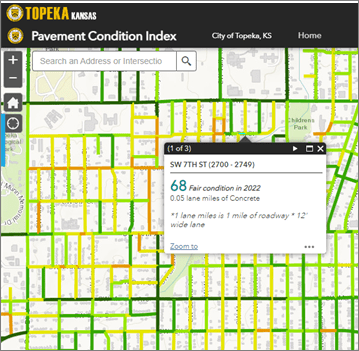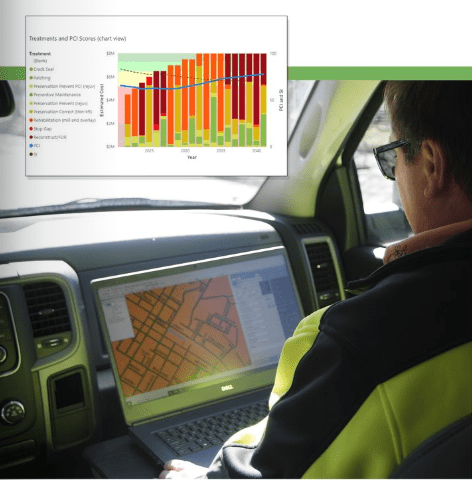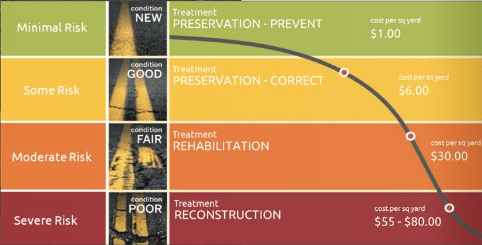In this second part of the Fundamentals of Asset Management for Pavement Management series, we will dive into answering the following questions:
- What assets do we own?
- Where are they located?
- What is their condition?
- What is their remaining useful life?
Roadways are the backbone of urban and rural communities, acting as conduits for commerce and transportation. The wear and tear of these pathways over time is inevitable. However, the response to such deterioration ultimately dictates the health, safety, and cost-effectiveness of a region’s transportation infrastructure. Asset management for pavement infrastructure covers the practices and methodologies that ensure our roads are safe, functional, and sustainably maintained. This article explains the importance of understanding the current state of road assets and how proactive measures can lead to more efficient and long-lasting roadways.
Current State of Assets
“Knowing where our road assets stand today is the first step to planning a smoother tomorrow.”
When we talk about asset management, it’s crucial to identify and define what situations we’re facing. Every county or municipality should be asking these key questions:
What assets do we own?
This is not just the length and breadth of the roads but also all the components that complete the transportation puzzle.
- Bridges and culverts act as crucial connectors and waterway management structures.
- Signage provides essential information, guiding road users safely on their journey. Lighting ensures nighttime visibility, enhancing safety and security.
- Traffic control measures, which include everything from traffic lights to pedestrian crossings, ensure the smooth flow of both vehicular and pedestrian traffic.
Each of these assets requires distinct maintenance strategies, influenced by their unique wear patterns and environmental factors.

Where are our assets located?
Geographic Information Systems (GIS) are essential tools in modern asset management. They not only help catalog the location of assets but also allow for the analysis of other relevant data like traffic density, climate patterns, and historical maintenance data. The power of GIS lies in its ability to visualize complex datasets, making it easier to spot trends, predict wear patterns, and prioritize maintenance tasks.
What is the asset’s condition?
This speaks to the asset’s current state, and if it requires repair or replacement. The “condition” goes beyond a mere visual assessment. For roads, several distress types can indicate underlying issues:
Surface Distresses: These include potholes, rutting, and cracks. Potholes might need filling, while more extensive cracking could signal foundational issues that require a more comprehensive fix.
- Structural Distresses: These result from issues like repeated heavy loads, indicating a failure in the structural integrity of the pavement. Signs include alligator cracking or large sections of crumbling pavement.
- Functional Distresses: Related to the interaction between the road and its users, examples include poor skid resistance or improper drainage causing water pooling.
Assessing these distresses can be done through various techniques, but each comes with its positives and negatives:
Manual Surveys: Traditionally, manual inspections have been the go-to method. This process involves physical inspection, measuring, and cataloging distress types.
- Pros: Direct human judgment can capture nuanced details.
- Cons: Labor-intensive, time-consuming, and might be subjective.

Automated Data Collection: This method uses specialized vehicles equipped with cameras and sensors to collect data.
- Pros: Faster, consistent data collection, covering larger areas in shorter time frames.
- Cons: Initial setup and equipment costs can be exorbitant.
Artificial intelligence (AI) Analysis: This approach incorporates AI to analyze data, often in conjunction with automated data collection.
- Pros: Provides insights at scale, quickly analyze vast datasets, and predicts future wear patterns.
- Cons: Requires quality input data and periodic training to adapt to new distress patterns. Human quality control is still required.
What is the asset’s remaining useful life?
It’s vital to understand when an asset is nearing the end of its useful life, allowing for timely budget allocations and planning. This concept ties in closely with degradation curves, which plot the deterioration of the pavement’s condition over time. As assets age, conditions naturally decline. However, the rate of this decline is influenced by factors like usage intensity, environmental conditions, and maintenance quality.
Understanding where an asset sits on its degradation curve helps in choosing the correct treatment and/or prevention options. For instance, early-stage distresses might benefit from preventive measures like crack sealing, while more advanced degradation might require structural overlays or complete resurfacing. It’s a balance between extending the asset’s life, wise spending, and safety.

Roadblock
A major hurdle that municipalities often face is the challenge of stale or missing data. Without accurate and up-to-date information, less-than-ideal decisions are made. This can result in inefficient resource allocation, increased maintenance costs, and longer delays for the public.
Recommendation
For effective asset management, it’s essential to conduct regular pavement condition surveys (PCS). This not only ensures that the data on hand is fresh but also provides insights into the changing dynamics of road wear and usage. For municipalities that lack the resources or expertise, outsourcing a PCS can be a viable solution. Additionally, collaboration is key to any successful project. Engaging with key people, from the public to city planners to emergency services, helps in defining asset information requirements based on the actual needs of decision-making bodies.
In Action
An exemplary case of strategic asset management in action is that of Topeka, Kansas. The City realized the importance of an accurate assessment and acted by commissioning an independent review of its street network. The findings were enlightening. In 2022, their streets scored an average Pavement Condition Index (PCI) of 64 out of 100. This was a maintaining their average condition from a PCI of 65 in 2019, but a large improvement from the 2016 PCI assessment of 54. This shows the condition trends of Topeka’s roads and the importance of periodic assessments.
The Road Ahead
Understanding the current state of road assets is just the beginning. It sets the stage for informed decision-making, forecasting future conditions, and effective resource allocation. With challenges such as climate change, increasing growth, and evolving transportation needs, the role of asset management for pavement infrastructure will only grow in significance.
As regions, cities, and towns evolve, their roads will bear the weight of that change. The journey towards a smoother tomorrow begins with knowing where we stand today. Through proactive measures, collaboration, and an emphasis on timely data gathering, municipalities can ensure that their roads remain pathways to progress.

